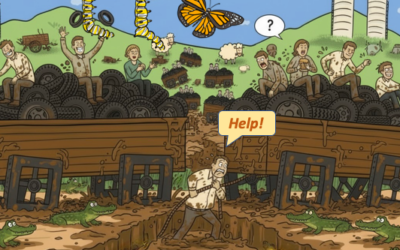I am watching the movie “Taxi Driver” and thinking about innovation: Checker Cabs used to be PERFECT tor fleets. Then, Poof! No more market. Hmmm.

And, of course there was Cybil Shepard. But that is a whole different story. 
For those who cannot remember, U.S. cab companies used yellow Checker cabs in the 1960s and 1970s primarily because they were purpose-built for taxi service, offering unique advantages that made them the industry standard for decades. So this is a somewhat oddball post from me about the general idea of innovation and change.
Checker Cabs was a BIG Player in the US (and maybe elsewhere).
Key Reasons for Checker Cab Industry Dominance:
1. Durability and Reliability were Excellent!
-
Checker cabs were engineered specifically for the rigors of taxi service, not as modified passenger cars. Their frames, suspensions, and bodies were robust, designed to withstand the constant stop-and-go, heavy loads, and rough urban streets that taxis endure.
- In those times, the auto industry made products that were not high quality. My parents bought a new car every three years because my dad did not want to deal with all the maintenance issues.
-
Checkers could run reliably for hundreds of thousands of miles, making them a cost-effective investment for fleet operators. And I was in dozens of them over the years.
2. Passenger and Driver Features
-
Checker cabs had wide rear doors, large back seats, and jump seats, allowing them to carry more passengers comfortably than typical sedans. You could fit 5 passengers in one easily with lots of luggage in the massive trunk.
-
The cars included features like adjustable driver seats (for long shifts) and easy-to-clean interiors—practical for high-turnover, high-use environments.
-
Exclusive features like “Air-n-Lite” ventilated glass roofs and landaulet tops were patented by Checker and enhanced the passenger experience.
3. Industry Relationships and Captive Market
-
Checker Motors not only made the cars but also owned and operated many of the largest taxi fleets in major cities like Chicago and New York. This vertical integration ensured a steady demand for their vehicles.
-
After acquiring rival companies and merging operations, Checker had a near-monopoly in several urban taxi markets, further cementing its dominance.
4. Regulatory and Market Fit
-
Many city regulations, especially in New York, were written around the Checker’s dimensions and capabilities, making it the default choice for compliance and probably a little cash to the regulators!
-
Checker cabs were among the first to hire African-American drivers and required all fares to be picked up, not just select passengers, which broadened their market appeal.
5. Lack of Competition = there were not a lot of alternatives!
-
For much of the mid-20th century, other manufacturers offered vehicles specifically tailored for taxi use. The Big Three automakers (GM, Ford, Chrysler) mainly sold modified passenger cars, which were less durable and less roomy than Checkers.
Why Did Checker’s Popularity Decline? Where did they miss the changes in the marketplace?
By the late 1960s and 1970s, Checker’s design began to badly show its age:
-
The cars were big, heavy gas guzzlers, which became a liability during the gas crises of the early 1970s. This drove up operating costs.
-
New safety, emissions, and fuel economy regulations made it harder for Checker to keep up without major redesigns that were just not planned.
-
The Big Three began offering more competitive, fleet-oriented models at lower prices, eroding Checker’s market share.
Checkers were the backbone of U.S. taxi fleets in the 1960s and 1970s because they were purpose-built, extremely durable, comfortable for passengers, and well-integrated into the taxi industry’s business and regulatory structures.
The decline came as the market and regulations and the whole marketplace began to change. The bigger automakers began to compete more aggressively on price and efficiency.
The lesson is clear as we have seen over and over: even the most purpose-built, beloved products will be swept aside if they fail to keep pace with shifting technology, regulation, and customer expectations. And there are LOTS of examples (like Blackberry devices).
Today, the taxi industry faces another wave of disruption—this time from self-driving cars, AI-powered fleet management, and sustainable electric vehicles. Plus, the cost of automobiles is getting WAY expensive given the economy. (Here in Cuenca, Ecuador, I rely on public transportation — Tranvia and bus rides are $.17 and taxi’s are CHEAP so who needs a car, with depreciation, insurance, and maintenance???)
Autonomous taxis promise to slash costs by eliminating drivers, optimize routes with real-time data, and offer safer, greener rides. The rise of ride-hailing apps and the push toward electric and autonomous fleets are reshaping urban mobility.
Just as Checker’s innovation once set the standard, today’s taxi industry must adapt to a landscape where efficiency, personalization, and sustainability are the new keys to survival. The Checker story should be a vivid reminder: standing still is not an option.
But then another thought as the movie continues – Robert DeNiro sure did a great job of planning and was certainly self-motivated. I guess there are some learning lessons there, too. And not much has changed when it comes to politics and wars and stuff between the 70s and today. We had high hopes in the late 70s…
I’m all in for continuous continuous innovation.
—
For the FUN of It!
 Dr. Scott Simmerman is a designer of team building games and organization improvement tools.
Dr. Scott Simmerman is a designer of team building games and organization improvement tools.
Managing Partner of Performance Management Company since 1984, he is an experienced presenter and consultant who is trying to retire!! He now lives in Cuenca, Ecuador.
You can reach Scott at scott@squarewheels.com
Learn more about Scott at his LinkedIn site.
Square Wheels® is a registered trademark of Performance Management Company
The Search for The Lost Dutchman’s Gold Mine is a trademark of Performance Management Company
Square Wheels and Lost Dutchman images © Performance Management Company, 1993 – 2024. All rights reserved.






0 Comments